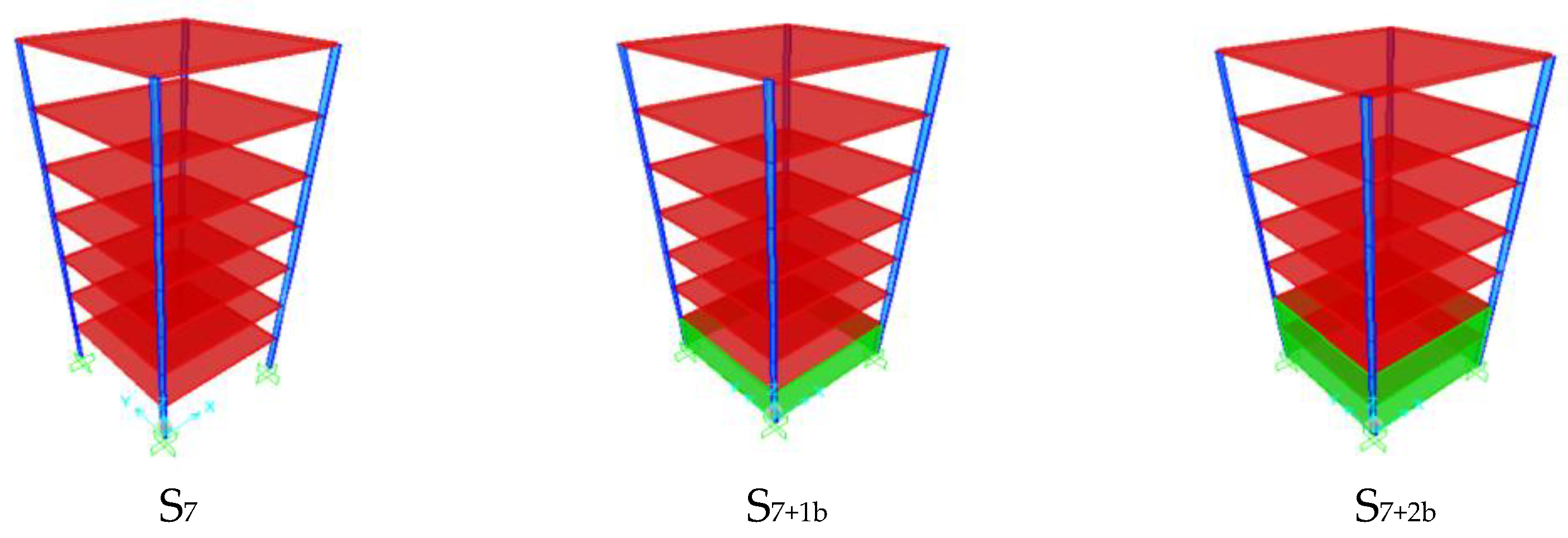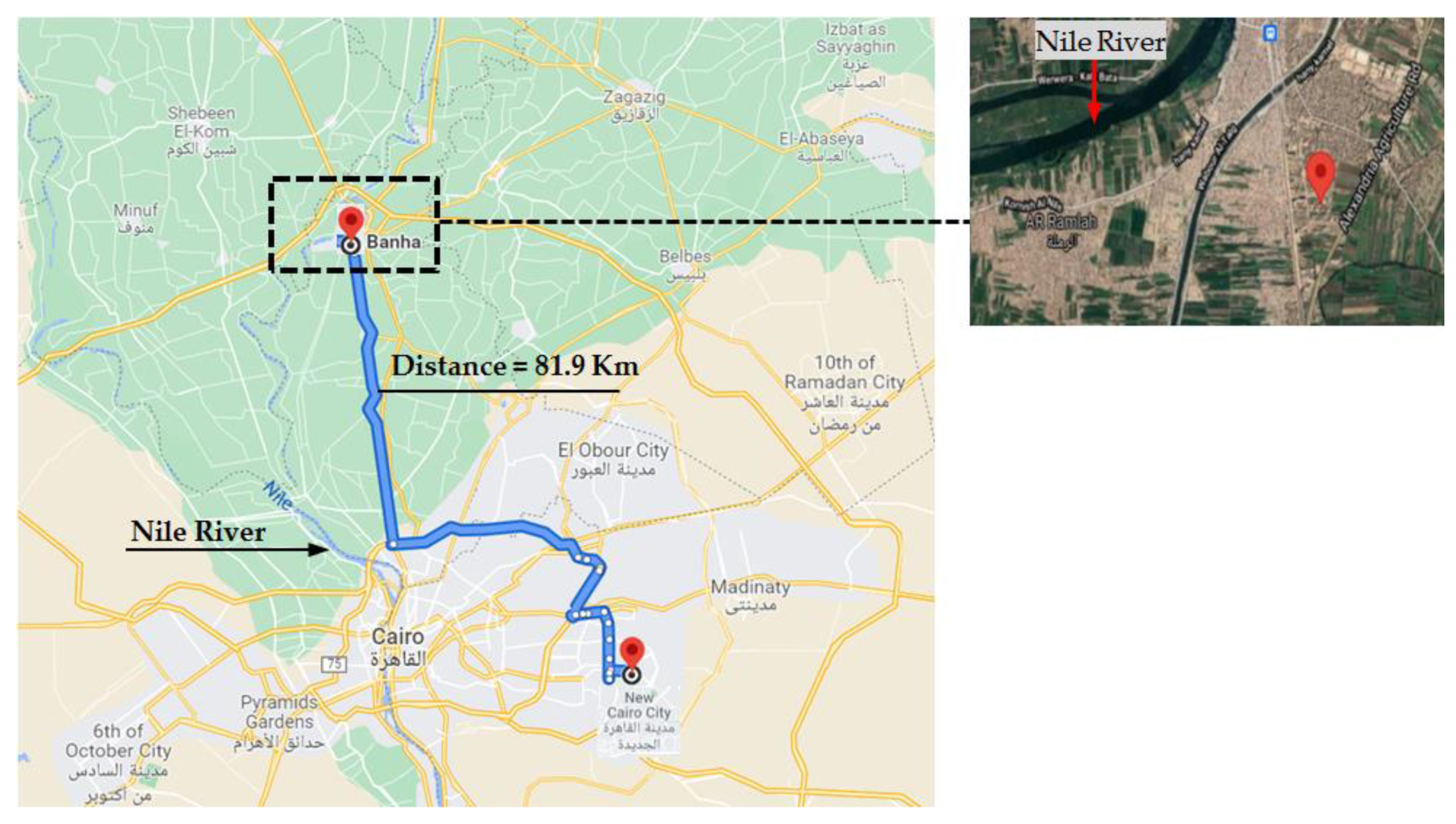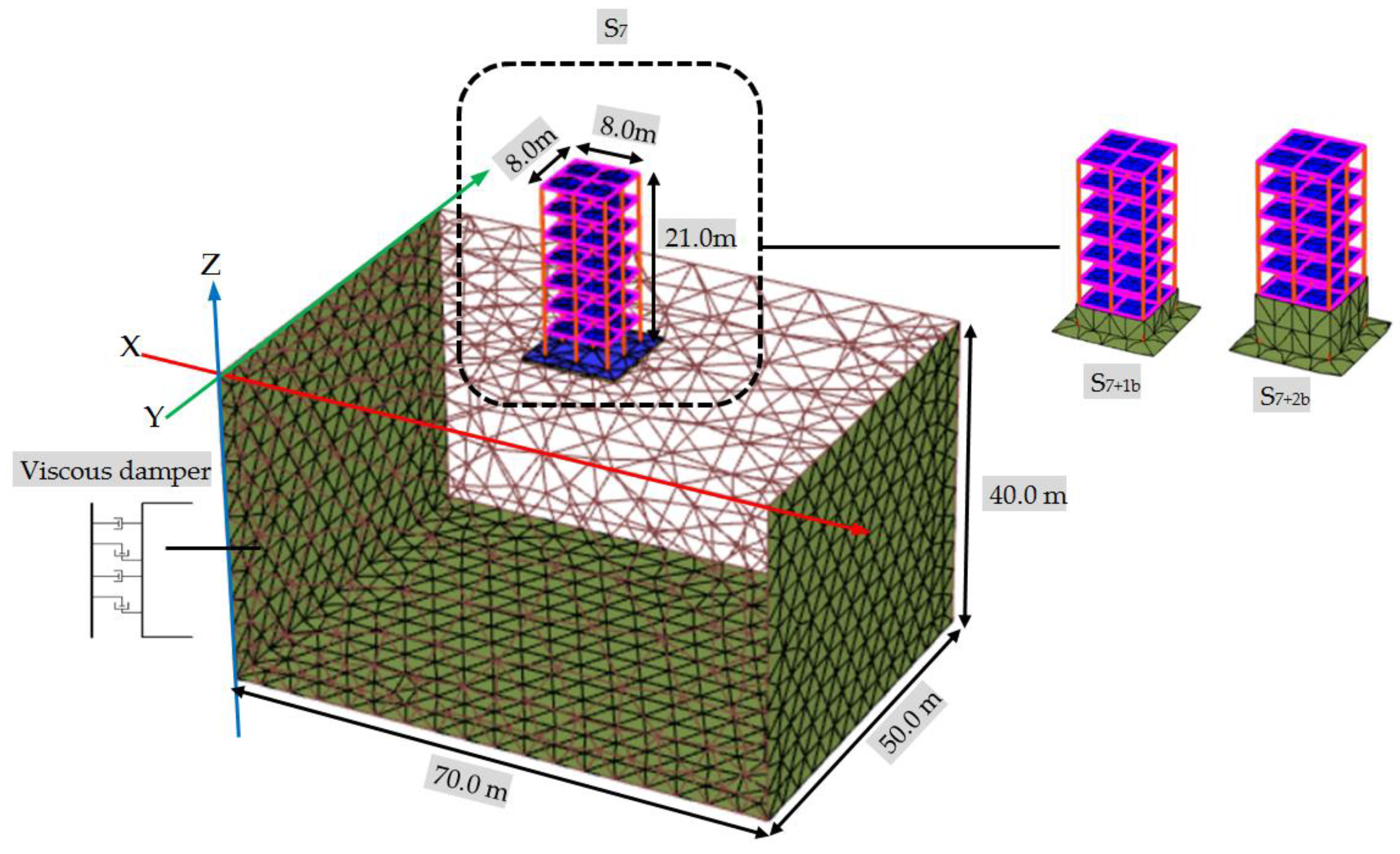Effect of Embedded Basement Stories on Seismic Response of Low-Rise Building Frames Considering SSI via Small Shaking Table Tests
Abstract
1. Introduction
2. Model Description
2.1. Real Characteristic of the Soil-Structure System
2.2. Scaling Coupled Models for Shaking Table Tests
Scaling Geotechnical Model and Soil Properties
2.3. Displacement Time Histories Records
3. Experimental Measurements
3.1. Shaking Table Tests without SSI Effects (a Fixed Base)
3.2. Shaking Table Tests with SSI Effects (a Flexible Base)
4. Numerical Simulations
4.1. Finite Element Analyses of Prototype and Scaled Models without SSI Effects (Fixed Base)
4.2. Finite Element Analyses of Prototype and Scaled Models with SSI Effects (Flexible Base)
5. Results and Discussion
5.1. Absolute Lateral Displacements of Three Scaled and Real Models
5.2. Relative Lateral Displacements of Three Scaled Models
5.3. Relative Lateral Displacements of Real Models
6. Conclusions
Author Contributions
Funding
Institutional Review Board Statement
Informed Consent Statement
Data Availability Statement
Acknowledgments
Conflicts of Interest
References
- Lysmer, J.; Udaka, T.; Tsai, C.; Seed, H.B. FLUSH-A Computer Program for Approximate 3-D Analysis of Soil-Structure Interaction Problems; University of California: Berkeley, CA, USA, 1975. [Google Scholar]
- Goktepe, F.; Sahin, M.; Celebi, E. Small Shaking Table Testing and Numerical Analysis of Free-Field Site Response and Soil-Structure Oscillation under Seismic Loading. Bull. Eng. Geol. Environ. 2020, 79, 2949–2969. [Google Scholar] [CrossRef]
- Stewart, J.P.; Seed, R.B.; Fenves, G.L. Empirical Evaluation of Inertial Soil-Structure Interaction Effects; Pacific Earthquake Engineering Research Center University of California: Berkeley, CA, USA, 1998. [Google Scholar]
- Beredugo, Y.O.; Novak, M. Coupled Horizontal and Rocking Vibration of Embedded Footings. Can. Geotech. J. 1972, 9, 477–497. [Google Scholar] [CrossRef]
- Hushmand, B. Experimental Studies of Dynamic Response of Foundations. Ph.D. Thesis, California Institute of Technology, Pasadena, CA, USA, 1984. [Google Scholar]
- Spyrakos, C.C.; Xu, C. Dynamic Analysis of Flexible Massive Strip-Foundations Embedded in Layered Soils by Hybrid BEM-FEM. Comput. Struct. 2004, 82, 2541–2550. [Google Scholar] [CrossRef]
- Livaoglu, R.; Dogangun, A. Effect of Foundation Embedment on Seismic Behavior of Elevated Tanks Considering Fluid–Structure-Soil Interaction. Soil Dyn. Earthq. Eng. 2007, 27, 855–863. [Google Scholar] [CrossRef]
- Makhmalbaf, M.O.; Alitalesh, M.; Samani, M.Z.; Tutunchian, M.A. Parametric Study on Displacements of Buildings Considering the Dynamic Soil-Structure Interaction Effects. Electron. J. Geotech. Eng. 2011, 16, 1617–1628. [Google Scholar]
- Fattah, M.Y.; Salim, N.M.; Al-Shammary, W.T. Effect of Embedment Depth on Response of Machine Foundation on Saturated Sand. Arab. J. Sci. Eng. 2015, 40, 3075–3098. [Google Scholar] [CrossRef]
- Hamood, M.; Abid, S. Effect of Foundation Embedment on the Response of a Multi-Story Building to Earthquake Excitation. MATEC Web Conf. 2018, 162, 3–8. [Google Scholar] [CrossRef][Green Version]
- Turan, A.; Hinchberger, S.D.; El Naggar, M.H. Seismic Soil–Structure Interaction in Buildings on Stiff Clay with Embedded Basement Stories. Can. Geotech. J. 2013, 50, 858–873. [Google Scholar] [CrossRef]
- Apsel, R.J.; Luco, J.E. Torsional response of rigid embedded foundation. ASCE J. Eng. Mech. Div. 1976, 102, 957–970. [Google Scholar] [CrossRef]
- Novak, M.; Sachs, K. Torsional and Coupled Vibrations of Embedded Footings. Earthq. Eng. Struct. Dyn. 1973, 2, 11–33. [Google Scholar] [CrossRef]
- Novak, M.; Beredugo, Y.O. Vertical Vibration of Embedded Footings. J. Soil Mech. Found. Div. 1972, 98, 1291–1310. [Google Scholar] [CrossRef]
- Stewart, J.P.; Fenves, G.L.; Seed, R.B. Seismic Soil-Structure Interaction in Buildings. I: Analytical Methods. J. Geotech. Geoenviron. Eng. 1999, 125, 26–37. [Google Scholar] [CrossRef]
- Mylonakis, G.; Nikolaou, S.; Gazetas, G. Footings under Seismic Loading: Analysis and Design Issues with Emphasis on Bridge Foundations. Soil Dyn. Earthq. Eng. 2006, 26, 824–853. [Google Scholar] [CrossRef]
- Kim, H.U.; Ha, J.G.; Ko, K.W.; Kim, D.S. Optimization of Two Soil-Structure Interaction Parameters Using Dynamic Centrifuge Tests and an Analytical Approach. Sustainability 2020, 12, 7113. [Google Scholar] [CrossRef]
- Urlich, C.M.; Kuhlemeyer, R.L. Coupled Rocking and Lateral Vibrations of Embedded Footings. Can. Geotech. J. 1973, 10, 145–160. [Google Scholar] [CrossRef]
- Wolf, J.P.; Darbre, G.R. Dynamic-stiffness Matrix of Soil by the Boundary-element Method: Embedded Foundation. Earthq. Eng. Struct. Dyn. 1984, 12, 401–416. [Google Scholar] [CrossRef]
- Gan, J.; Li, P.; Liu, Q. Study on Dynamic Structure-Soil-Structure Interaction of Three Adjacent Tall Buildings Subjected to Seismic Loading. Sustainability 2020, 12, 336. [Google Scholar] [CrossRef]
- Castelli, F.; Grasso, S.; Lentini, V.; Sammito, M.S.V. Effects of Soil-Foundation-Interaction on the Seismic Response of a Cooling Tower by 3D-FEM Analysis. Geosciences 2021, 11, 200. [Google Scholar] [CrossRef]
- Forcellini, D. Soil-Structure Interaction Analyses of Shallow-Founded Structures on a Potential-Liquefiable Soil Deposit. Soil Dyn. Earthq. Eng. 2020, 133, 106108. [Google Scholar] [CrossRef]
- Forcellini, D. Seismic Assessment of a Benchmark Based Isolated Ordinary Building with Soil Structure Interaction. Bull. Earthq. Eng. 2018, 16, 2021–2042. [Google Scholar] [CrossRef]
- Forcellini, D. A Novel Framework to Assess Soil Structure Interaction (SSI) Effects with Equivalent Fixed-Based Models. Appl. Sci. 2021, 11, 10472. [Google Scholar] [CrossRef]
- Zaicenco, A.; Alkaz, V. Soil-Structure Interaction Effects on an Instrumented Building. Bull. Earthq. Eng. 2007, 5, 533–547. [Google Scholar] [CrossRef]
- Ko, Y.-Y.; Chen, C.-H. Soil-Structure Interaction Effects Observed in the in Situ Forced Vibration and Pushover Tests of School Buildings in Taiwan and Their Modeling Considering the Foundation Flexibility. Earthq. Eng. Struct. Dyn. 2010, 39, 945–966. [Google Scholar] [CrossRef]
- Michel, C.; Zapico, B.; Lestuzzi, P.; Molina, F.J.; Weber, F. Quantification of Fundamental Frequency Drop for Unreinforced Masonry Buildings from Dynamic Tests. Earthq. Eng. Struct. Dyn. 2011, 40, 1283–1296. [Google Scholar] [CrossRef]
- Goktepe, F.; Celebi, E.; Omid, A.J. Numerical and Experimental Study on Scaled Soil-Structure Model for Small Shaking Table Tests. Soil Dyn. Earthq. Eng. 2019, 119, 308–319. [Google Scholar] [CrossRef]
- Tabatabaiefar, S.H.R. Determining Seismic Response of Mid-Rise Building Frames Considering Dynamic Soil-Structure Interaction. Master’s Thesis, University of Technology Sydney, Sydney, Australia, 2012. [Google Scholar]
- Lee, C.J.; Wei, Y.C.; Kuo, Y.C. Boundary Effects of a Laminar Container in Centrifuge Shaking Table Tests. Soil Dyn. Earthq. Eng. 2012, 34, 37–51. [Google Scholar] [CrossRef]
- Ahn, S.; Park, G.; Yoon, H.; Han, J.H.; Jung, J. Evaluation of Soil–Structure Interaction in Structure Models via Shaking Table Test. Sustainability 2021, 13, 4995. [Google Scholar] [CrossRef]
- Trifunac, M.D.; Todorovska, M.I.; Manić, M.I.; Bulajić, B.D. Variability of the Fixed-Base and Soil--Structure System Frequencies of a Building—The Case of Borik-2 Building. Struct. Control Health Monit. Off. J. Int. Assoc. Struct. Control Monit. Eur. Assoc. Control Struct. 2010, 17, 120–151. [Google Scholar] [CrossRef]
- Abate, G.; Gatto, M.; Massimino, M.R.; Pitilakis, D. Large Scale Soil-Foundation-Structure Model in Greece: Dynamic Tests vs FEM Simulation. In Proceedings of the 6th ECCOMAS Thematic Conference on Computational Methods in Structural Dynamics and Earthquake Engineering, Rhodes Island, Greece, 15–17 June 2017. COMPDYN; 2017. [Google Scholar]
- Campiche, A. Numerical Modelling of Cfs Three-Story Strap-Braced Building under Shaking-Table Excitations. Materials 2021, 14, 118. [Google Scholar] [CrossRef]
- Tabatabaiefar, S.; Fatahi, B.; Samali, B. Numerical and Experimental Investigations on Seismic Response of Building Frames under Influence of Soil-Structure Interaction. Adv. Struct. Eng. 2014, 17, 109–130. [Google Scholar] [CrossRef]
- Hosseinzadeh, N.; Davoodi, M.; Rayat Roknabadi, E. Shake Table Study of Soil Structure Interaction Effects in Surface and Embedded Foundations. In Proceedings of the 15th World Conference on Earthquake Engineering, Lisbon, Portugal, 24–28 September 2012; pp. 24–28. [Google Scholar]
- Chunyu, T.; Congzhen, X.; Hong, Z.; Jinzhe, C. Shaking Table Test and Seismic Performance Evaluation of Shanghai Tower. Int. J. High-Rise Build. 2012, 1, 221–228. [Google Scholar] [CrossRef]
- Lu, X.; Yin, X.; Jiang, H. Shaking Table Scaled Model Test on a High-Rise Building with CFT Frame and Composite Core Wall. Eur. J. Environ. Civ. Eng. 2013, 17, 616–634. [Google Scholar] [CrossRef]
- Taylor, C.A. Large Scale Shaking Tests of Geotechnical Structures: Report No. 3; Laboratorio Nacional de Engenharia Civil: Lisboa, Portugal, 1997. [Google Scholar]
- Prasad, S.K.; Towhata, I.; Chandradhara, G.P.; Nanjundaswamy, P. Shaking Table Tests in Earthquake Geotechnical Engineering. Curr. Sci. 2004, 1398–1404. [Google Scholar]
- Pitilakis, D.; Dietz, M.; Wood, D.M.; Clouteau, D.; Modaressi, A. Numerical Simulation of Dynamic Soil-Structure Interaction in Shaking Table Testing. Soil Dyn. Earthq. Eng. 2008, 28, 453–467. [Google Scholar] [CrossRef]
- Chau, K.T.; Shen, C.Y.; Guo, X. Nonlinear Seismic Soil–Pile–Structure Interactions: Shaking Table Tests and FEM Analyses. Soil Dyn. Earthq. Eng. 2009, 29, 300–310. [Google Scholar] [CrossRef]
- Brinkgreve, R.B. Plaxis 3D; Plaxis Bv.: Delft, The Netherland, 2012. [Google Scholar]
- SAP. Integrated Finite Element Analysis and Design of Structures Graphic User Interface Manual; Computers and Structures, Inc.: Berkley, CA, USA, 2000. [Google Scholar]
- Krawinkler, H.; Moncarz, P.D. Theory and Application of Experimental Model Analysis in Earthquake Engineering. NASA STI/Recon Tech. Rep. N 1981, 82, 18430. [Google Scholar]
- Gazetas, G. Vibrational Characteristics of Soil Deposits with Variable Wave Velocity. Int. J. Numer. Anal. Methods Geomech. 1982, 6, 1–20. [Google Scholar] [CrossRef]
- Cheung, W.M.; Qin, X.; Chouw, N.; Larkin, T.; Orense, R. Experimental and Numerical Study of Soil Response in a Laminar Box. In Proceedings of the 2013 NZSEE Conference, Wellington, NZ, USA, 26–28 April2013. [Google Scholar]
- El Hoseny, M.; Jianxun, M.; Dawoud, W. Experimental Studies and Numerical Simulations on Seismic Analysis of Tall Building with Variable Embedded Depths Considering Soil-Structure Interaction. Bull. Earthq. Eng. under review.
- Gohl, W.B.; Finn, W.D.L. Seismic Response of Single Piles in Shaking Table Studies. In Proceedings of the the Fifth Canadian Conference Earthquake Engineering, Ottawa, CA, Canada, 6–8 July 1987; pp. 435–444. [Google Scholar]
- PEER Strong Motion Database. Available online: https://peer.berkeley.edu/ (accessed on 8 December 2021).
- Lysmer, J.; Kuhlemeyer, R.L. Finite Dynamic Model for Infinite Media. J. Eng. Mech. Div. 1969, 95, 859–877. [Google Scholar] [CrossRef]
- Kramer, S.L. Geotechnical Earthquake Engineering; Pearson Education: Noida, India, 1996. [Google Scholar]















| S7 | S7+1b | S7+2b | |
|---|---|---|---|
| Natural Frequency (Hz) | 1.62 | 1.84 | 2.26 |
| Total Mass (tones) | 645 | 706 | 767 |
| Mass Density | 1 | Acceleration | 1 | Length | λ |
|---|---|---|---|---|---|
| Force | λ3 | Shear wave velocity | λ0.5 | Stress | λ |
| Stiffness | λ2 | Time | λ0.5 | Strain | 1 |
| Modulus | λ | Frequency | λ−0.5 | EI | λ5 |
| Geometric Scaling Factors | Width of Structure (m) | Length of Structure (m) | Height of Structure (m) | Length of Soil (m) | Width of Soil (m) | Depth of Soil (m) | Volume of Soil (m3) | Mass (Kg) |
|---|---|---|---|---|---|---|---|---|
| 1:1 | 8.0 | 8.0 | 21.0 | 70.0 | 50.0 | 40.0 | 140,000 | 249,200,000 |
| 1:10 | 0.80 | 0.80 | 2.1 | 7 | 5 | 4 | 140 | 249,200 |
| 1:20 | 0.40 | 0.40 | 1.05 | 3.5 | 2.5 | 2 | 17.5 | 31,150 |
| 1:40 | 0.20 | 0.20 | 0.525 | 1.75 | 1.25 | 1.0 | 2.1875 | 3893.75 |
| 1:50 | 0.16 | 0.16 | 0.42 | 1.4 | 1.0 | 0.8 | 1.12 | 1993.6 |
| S7 | S7+1b | S7+2b | |
|---|---|---|---|
| Natural Frequency (Hz) | 11.45 | 13.01 | 15.98 |
| Total Mass (Kg) | 5.16 | 5.64 | 6.13 |
| S7 | S7+1b | S7+2b | |
|---|---|---|---|
| Natural Frequency (Hz) | 11.56 | 13.35 | 15.78 |
| Total Mass (Kg) | 5.06 | 5.51 | 5.98 |
| Parameter | Symbol | Magnitude | Unit |
|---|---|---|---|
| Average unit weight | γ | 17.8 | kN/m3 |
| Shear modulus | G | 1758 | kN/m2 |
| Young modulus | E | 4571 | kN/m2 |
| Poisson’s ratio | ν | 0.3 | --- |
| Shear wave velocity | Vs | 31.13 | m/s |
| Compression wave velocity | Vp | 58.23 | m/s |
| Cohesion | C | 60 | kN/m2 |
| Friction angle | Φ | 31.8 | (°) |
| Dilatancy angle | Ψ | 1.8 | (°) |
| Earthquake | Country | Date | PGA (g) | Mw (R) | Duration(s) | Station |
|---|---|---|---|---|---|---|
| Northridge | USA | Jan. 1994 | 0.57 | 6.7 | 40 | CDMG STATION 24278 |
| Kobe | Japan | Jan. 1995 | 0.34 | 6.9 | 40 | KAKOGAWA |
| Chi-Chi | Taiwan | Sep. 1999 | 0.36 | 7.6 | 120 | CHY006 |
| Northridge (1994) Earthquake | Kobe (1995) Earthquake | Chi-Chi (1999) Earthquake | ||||||||||
|---|---|---|---|---|---|---|---|---|---|---|---|---|
| Scaled model | Real | Average geometric scale (1/λ = 50) | Scaled model | Real | Average geometric scale (1/λ = 50) | Scaled model | Real | Average geometric scale (1/λ = 50) | ||||
| Exp. (mm) | Num. (mm) | Num. (mm) | Exp. (mm) | Num. (mm) | Num. (mm) | Exp. (mm) | Num. (mm) | Num. (mm) | ||||
| S7 | 1.89 | 1.89 | 116 | 61 | 1.85 | 1.93 | 105 | 55 | 5.04 | 5.00 | 275 | 55 |
| S7+1b | 1.79 | 1.73 | 107 | 60 | 1.70 | 1.70 | 102 | 60 | 4.80 | 4.82 | 263 | 55 |
| S7+2b | 1.60 | 1.69 | 106 | 64 | 1.66 | 1.69 | 98 | 58 | 4.53 | 4.80 | 262 | 56 |
| Northridge (1994) Earthquake | Kobe (1995) Earthquake | Chi-Chi (1999) Earthquake | ||||||||||
|---|---|---|---|---|---|---|---|---|---|---|---|---|
| Scaled model | Real | Average geometric scale (1/λ = 50) | Scaled model | Real | Average geometric scale (1/λ = 50) | Scaled model | Real | Average geometric scale (1/λ = 50) | ||||
| Exp. (mm) | Num. (mm) | Num. (mm) | Exp. (mm) | Num. (mm) | Num. (mm) | Exp. (mm) | Num. (mm) | Num. (mm) | ||||
| S7 | 1.93 | 1.92 | 129 | 67 | 1.98 | 2.05 | 117 | 58 | 5.30 | 5.45 | 292 | 54 |
| S7+1b | 1.91 | 1.90 | 119 | 62 | 1.87 | 1.98 | 113 | 59 | 5.04 | 4.90 | 290 | 58 |
| S7+2b | 1.75 | 1.75 | 108 | 62 | 1.80 | 1.93 | 105 | 56 | 4.70 | 4.80 | 286 | 60 |
Publisher’s Note: MDPI stays neutral with regard to jurisdictional claims in published maps and institutional affiliations. |
© 2022 by the authors. Licensee MDPI, Basel, Switzerland. This article is an open access article distributed under the terms and conditions of the Creative Commons Attribution (CC BY) license (https://creativecommons.org/licenses/by/4.0/).
Share and Cite
El Hoseny, M.; Ma, J.; Josephine, M. Effect of Embedded Basement Stories on Seismic Response of Low-Rise Building Frames Considering SSI via Small Shaking Table Tests. Sustainability 2022, 14, 1275. https://doi.org/10.3390/su14031275
El Hoseny M, Ma J, Josephine M. Effect of Embedded Basement Stories on Seismic Response of Low-Rise Building Frames Considering SSI via Small Shaking Table Tests. Sustainability. 2022; 14(3):1275. https://doi.org/10.3390/su14031275
Chicago/Turabian StyleEl Hoseny, Mohammed, Jianxun Ma, and Musanyufu Josephine. 2022. "Effect of Embedded Basement Stories on Seismic Response of Low-Rise Building Frames Considering SSI via Small Shaking Table Tests" Sustainability 14, no. 3: 1275. https://doi.org/10.3390/su14031275
APA StyleEl Hoseny, M., Ma, J., & Josephine, M. (2022). Effect of Embedded Basement Stories on Seismic Response of Low-Rise Building Frames Considering SSI via Small Shaking Table Tests. Sustainability, 14(3), 1275. https://doi.org/10.3390/su14031275






